How to Grow Garlic in Your Greenhouse or Cold Frame
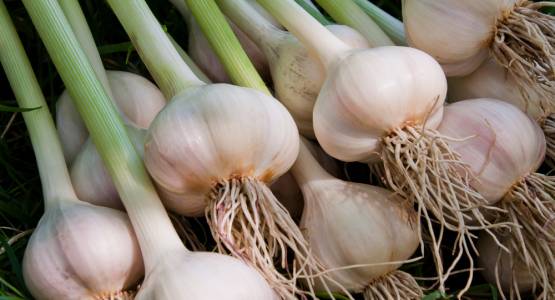
Growing garlic in a greenhouse can be a rewarding and an efficient way to cultivate this versatile and flavourful vegetable. A tasty and healthy addition to lots of savoury dishes, garlic is one of the most popular vegetables you can buy. It is also a great way to get children interested in food sources and gardening.
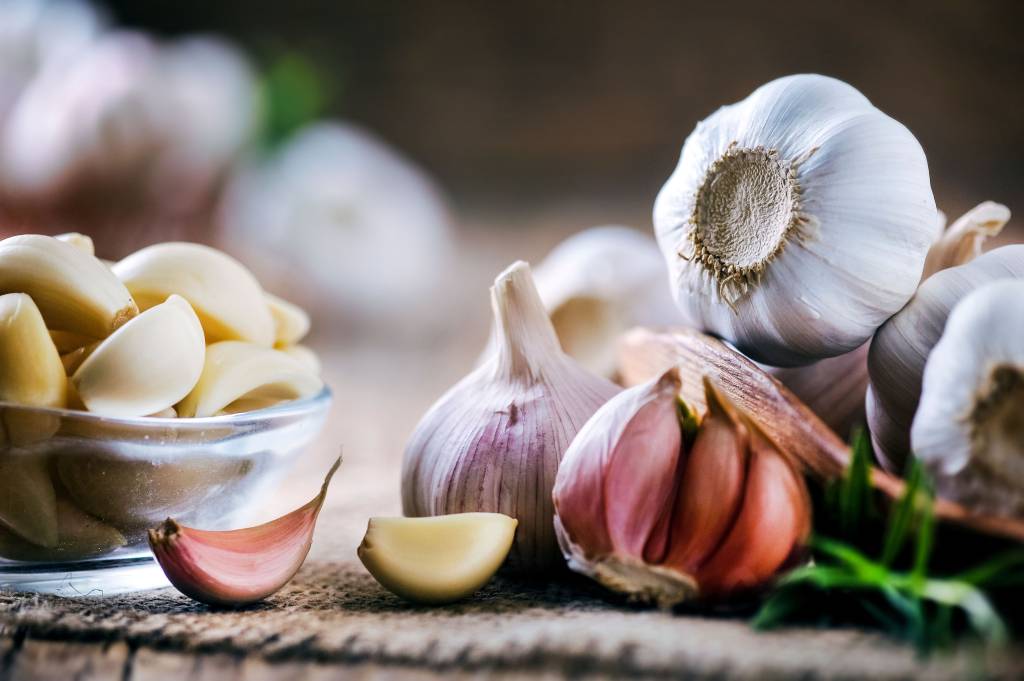
In this blog, we will tell you how to grow garlic in your miniature greenhouse or cold frame. These structures both benefit for the protection of the glass, allowing you to grow garlic year-round in the UK.
The benefits of growing garlic in your greenhouse
Extend your season of growth
One of the main benefits of a greenhouse is the ability to grow organic vegetables all year round. Just pop out to the garden to pick your crops at food preparation time.
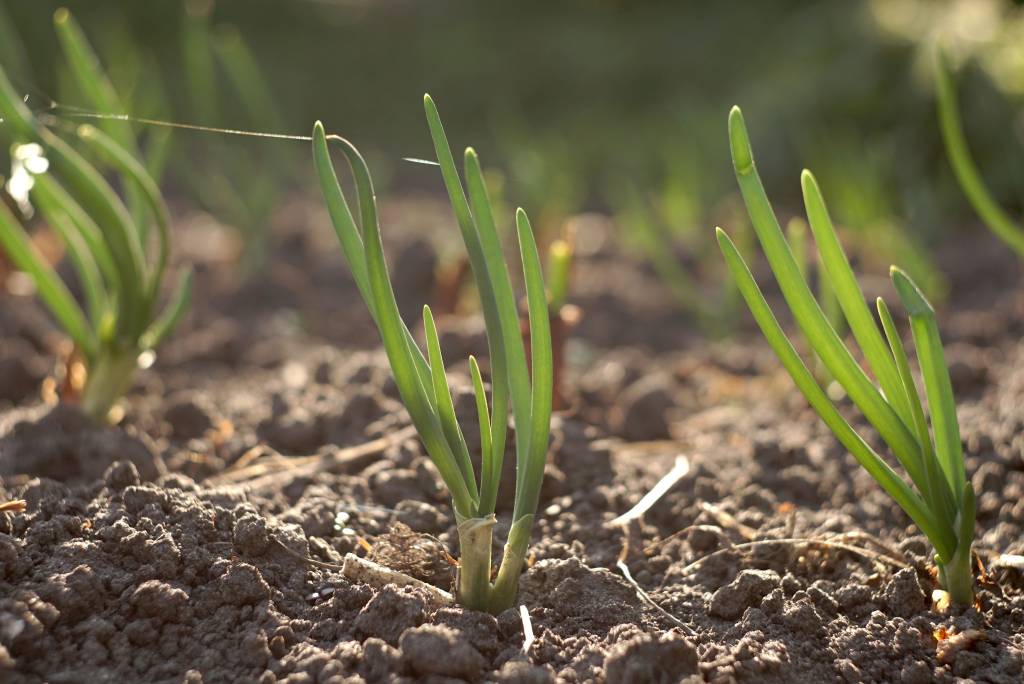
Plant your garlic cloves in trays or pots at different times so that fresh garlic is always ready for picking.
Protect your garlic plants
Garlic is susceptible to damage from extreme weather conditions. A greenhouse will shield your plants from the elements, ensuring consistent growth and minimising the risk of disease. A greenhouse will also keep common pests at bay and reduce the risk of fungal disease.
The preferred soil temperature is between 40 and 50 degrees Fahrenheit (4 to 10 Celsius) and garlic plants love sunshine.
Take away the worry of watering
In a greenhouse you can water your plants in a controlled, measured way, monitoring the moisture levels as required preventing water logging from downpours or drought stress from dry periods. Many Access Mini greenhouses and Cold Frames have the option of a built-in watering system to make the task even easier. Garlic plants do not need watering during the last 2 – 4 weeks before harvesting.
Space utilisation
Find the perfect sized greenhouse for your available space, from a range of choices including a mini growhouse for the smaller garden, or a classic greenhouse for larger areas.
Companion Planting
Companion planting is where planting one plant near to another provides benefits to the other plants. Garlic is a great companion plant as the sulphur that builds up in the garlic plants acts as a natural deterrent to pests in the garden. Plant Garlic near to tomatoes, carrots, cabbages and potatoes to provide additional protection for those plants. You can also use garlic as a natural pest control spray – use this recipe from TheGarlicFarm.
Choosing your garlic plants
There are two categories of garlic – hardneck and softneck. Within the two categories there are many varieties to choose from.
Hardneck garlic produces fewer, larger cloves. It has a stronger flavour, and it’s leaves, known as scapes, can also be used for culinary purposes such as in salads or in stir fries. Some popular hardneck varieties include Rocambole, Porcelain, and Purple Stripe, each offering distinctive taste profiles and vibrant colours in cooking.
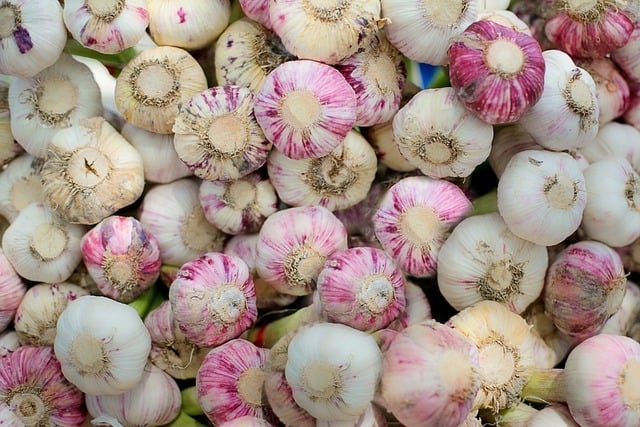
Softneck garlic varieties are favoured for their long shelf life and mild, versatile flavour. Commonly found in grocery stores, they have soft stems that allow for braiding, making them perfect for decorative kitchen displays. Popular softneck varieties include Silverskin and Artichoke, renowned for their adaptability in various cuisines, from Italian to Asian dishes. Softneck garlic produces smaller, more tightly squeezed cloves, has a more subtle flavour, and can be stored for longer.
When can you grow garlic?
If you want to plant garlic in the UK, you can plant between October and February and then harvest between June and August – just in time for summer cooking! Therefore, it may be worth preparing your soil and where you’re going to grow it in September.
How to grow garlic
Now that you’ve chosen what variety of garlic you want to grow, you’re now ready to plant. Here are some simple steps to get you going:
- Buy some seed garlic from a garden supplier. Do not be tempted to use garlic from the supermarket, it may not be suited to UK soil or could carry diseases.
- Separate the bulb of garlic into cloves leaving the papery husk on to provide extra protection during the early growth period.
- Plant each clove 3 – 5 cm (1-2″) from the top of the soil, pointy end up, leaving room in between for the bulb to grow (bear this in mind if you are growing elephant garlic).
- Cover the cloves with an organic mulch (hay or dried leaves are good options).
- Feed the cloves with fertiliser a few times before the bulbs begin to swell. The swell stage can be identified when the leaves above the soil begin to yellow.
- A sprinkle of Epsom Salts over the planting bed can build up the strength of your plants. It takes between 6 to 8 months until the garlic is at the “ready to pick” stage.
Can I grow garlic in a container or in the ground?
You can grow garlic both in containers and in the ground, but there are some differences to consider:
Growing garlic in containers:
- Containers are a great option if you have limited garden space or poor soil quality.
- Choose a container that is at least 8-10 inches deep and has drainage holes to prevent waterlogging.
- Use a high-quality potting mix with good drainage properties.
- Plant garlic cloves in the container in the same way as in the ground, with the pointed end facing up, and space them as recommended.
- Place the container in a sunny location where it receives 6-8 hours of sunlight per day.
- Container-grown garlic may need more frequent watering than those in the ground since containers tend to dry out faster. Keep the soil consistently moist but not waterlogged.
- Fertilise container-grown garlic as needed, following the same guidelines for in-ground planting.
- Harvest and cure the garlic bulbs as you would with in-ground garlic.
Growing garlic in the ground:
- Growing garlic in the ground is a traditional method and allows for larger yields.
- Prepare the garden bed by amending the soil with organic matter to improve fertility and drainage.
- Plant garlic cloves directly in the ground in the autumn, following the spacing and depth recommendations.
- Weeding is essential to keep the area around your garlic clear.
- In-ground garlic may require less frequent watering compared to container-grown garlic due to the ground’s ability to retain moisture.
- Fertilise according to soil test results or with a balanced fertiliser in the spring.
- Harvest and cure in-ground garlic as recommended.
Ultimately, the choice between growing garlic in a container or in the ground depends on your available space and preferences. Both methods can yield delicious garlic, but container gardening is more suitable for those with limited space or less-than-ideal soil conditions.
Growing garlic in modules:
If the ground in the garden is heavy or damp, it is best to plant the garlic cloves in modules and then keep them inside a greenhouse or cold frame over the winter months, ready for transplanting in the spring time. This will also help the garlic get a head start in the spring.
Top tips for growing garlic
- Save some of the larger cloves from your fully grown bulbs for replanting for your next crop.
- Do not use soil that allium plants have previously grown in as it could restrict the growth of your garlic plant.
- To improve bulb size, water garlic during dry spells, but don’t water once the bulbs are large and well formed as this could encourage rotting.
- As garlic needs full sun, keep weeds at bay to ensure the plants don’t get shaded.
- Remove any flowers that stem otherwise the growing energy will cause bolting rather than swelling the bulb.
How to harvest garlic
Harvesting garlic at the right time is crucial to ensure you get the best flavour and storage life from your bulbs. Here are the steps to harvest garlic:
- Timing – garlic is typically ready for harvest in early to mid-summer, usually in June or July, depending on when you planted it and your local climate. You’ll know it’s time when the lower leaves of the garlic plant start to turn yellow and wither.
- Prepare – before you start harvesting, gently loosen the soil around the garlic bulbs using a garden fork or trowel. Be careful not to damage the bulbs while doing this.
- Lift carefully – to avoid damaging the garlic bulbs, insert the fork or trowel under the bulbs and lift them out of the soil gently. Try to keep as much soil as possible attached to the roots.
- Shake off excess soil – once you’ve lifted the bulbs, gently shake off excess soil, but don’t wash them. Washing can introduce moisture, which may lead to rot during curing and storage.
- Curing – after harvesting, it’s essential to cure the garlic bulbs. This process allows them to dry, which improves their flavour and helps with storage. To cure garlic, lay the bulbs in a single layer in a dry, well-ventilated area away from direct sunlight. A garage, shed, or porch can work well for this purpose. Hang the garlic in bundles or spread it out on screens or racks. Leave them to cure for about two to four weeks.
- Trimming – after the garlic bulbs have cured, trim the roots and cut off the tops, leaving about an inch of the stem attached. This step helps to tidy up the bulbs and prepares them for long-term storage.
How to store garlic
Garlic will last for months if it’s stored in a dark, dry place and it won’t last as long if it stored in a refrigerator. Garlic should be stored in a cool, dry place with good air circulation, such as a pantry or countertop.
Avoid exposing it to direct sunlight or moisture, as it can cause sprouting or mould and use a mesh bag or a basket to promote airflow and prevent premature spoiling.
How to prepare garlic
To prepare garlic for cooking, start by separating the cloves from the bulb. Place a clove under a flat side of a knife and press down to crush it slightly, making it easier to peel.
Remove the skin, then finely chop, mince, or crush the garlic, releasing its flavour. Use in your favourite dishes for a rich, aromatic taste.
If you have got too many garlic cloves to use immediately, you can grate or chop your garlic into ice cube trays, cover it with oil and freeze.
Common problems and diseases
Growing garlic can be relatively trouble-free, but like all plants, garlic is susceptible to certain problems and diseases. Here are some common issues you may encounter when growing garlic:
Leek rust
Leek rust is a fungal disease that affects various members of the Allium family, including garlic, onions, leeks, and chives. It typically appears as orange or brownish-red pustules or rust-coloured spots on the leaves.
Onion fly
The onion fly is a common pest that can also affect garlic and is a small fly with a greyish body. Adult onion flies lay their eggs near the base of garlic plants and the larvae (maggots) that hatch from these eggs burrow into the plant’s stems and bulbs, causing wilting and damage. You may notice yellowing leaves and the presence of maggots if your garlic is infested.
White rot
This soil-borne fungus can decimate garlic crops. It causes yellowing and wilting of leaves and a white mold on the bulbs. Prevention includes practicing crop rotation and avoiding planting garlic in previously infected soil.
Eelworms
Eelworms, or nematodes, are microscopic roundworms that can infest garlic and other plants. They can cause various symptoms depending on the type of nematode and the level of infestation.
Root maggots
These small, yellowish maggots feed on garlic roots, causing the plants to wilt and decline. Use row covers to protect garlic from these pests and practice crop rotation.
Aphids
These can infest garlic and cause stunted growth and yellowing of leaves. They can be controlled with insecticidal soap or by introducing beneficial insects like ladybugs.
Weeds
Weeds can compete with garlic for nutrients and water. Regular weeding is essential to prevent weed interference.
Inadequate watering
Inconsistent or inadequate watering can lead to small or misshapen garlic bulbs. Keep the soil consistently moist but not waterlogged.
Overcrowding
Planting garlic cloves too closely together can result in smaller bulbs because they compete for resources. Ensure proper spacing when planting.
Bolting
Bolting occurs when garlic plants send up a flower stalk prematurely, which can result from exposure to cold temperatures or other environmental stressors. Garlic scapes (flower stalks) should be removed to redirect the plant’s energy back to bulb development.
To minimise these problems and diseases when growing garlic, it’s essential to start with healthy cloves, practice good sanitation, maintain proper spacing and watering, and provide adequate ventilation during curing. Additionally, crop rotation can help reduce the risk of soil-borne diseases. If you notice signs of disease or infestation, take prompt action to address the issue and prevent further spread.
Recipes that use garlic
Garlic is a versatile ingredient that enhances the flavour of countless dishes.
For a classic pasta recipe, sauté minced garlic and chopped chilli in olive oil and toss with spaghetti (or any pasta you fancy) for a simple, yet flavourful spaghetti aglio e olio.
Roasting whole garlic bulbs brings out their sweetness, perfect for spreading on crusty bread or mixing into mashed potatoes.
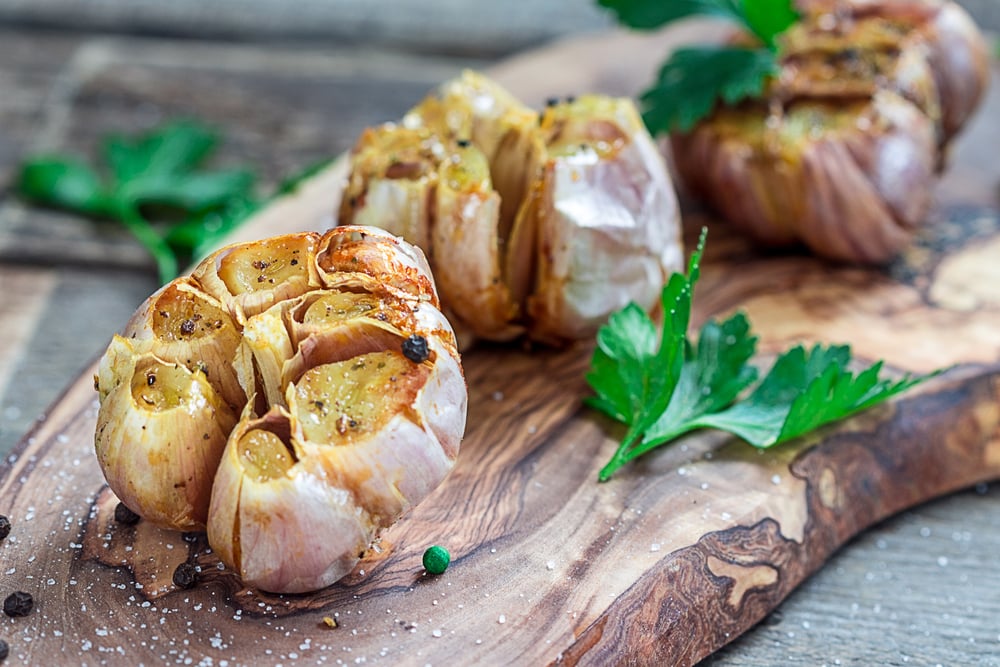
In Greek cuisine, garlic shines in tzatziki sauce with yogurt, cucumber, lemon juice and herbs and in Greek-style slow roasted lamb with a garlic rub.
For Asian-inspired dishes, stir-fry minced garlic with ginger and soy sauce for a savoury base, or use it in a fragrant Thai green curry.
Garlic butter is also a great addition to meat and vegetables. Crush some garlic, mix well with butter, season and add chopped parsley. A spoonful can transform your roast potatoes into a flavour sensation or slather onto a pizza base or dough balls.
Whether in soups, marinades, or as a topping for grilled meats and vegetables, garlic adds depth and richness to your culinary creations. Experiment and enjoy the incredible range of flavours it offers.
